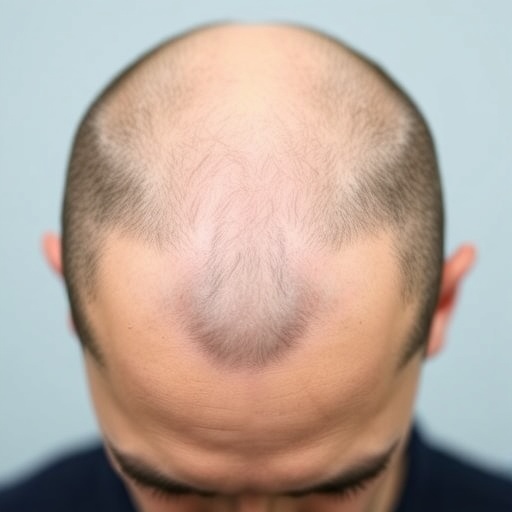In a groundbreaking study published in Scientific Reports, researchers led by Xi et al. unveiled an innovative approach to understanding and stratifying male pattern hair loss (MPHL) using artificial intelligence (AI). This significant advancement not only illustrates the intersection of biotechnology and machine learning but also offers hope for millions affected by this condition. The study introduces a novel analytical framework known as loss region ratio analysis, which aims to enhance the diagnostic accuracy and treatment pathways for individuals experiencing MPHL.
Male pattern hair loss is a prevalent condition affecting a substantial portion of the male population worldwide. Traditionally characterized by a progressive thinning of hair on the crown and temples, the etiology of this condition remains largely elusive, despite its widespread occurrence. The contemporary diagnostic methodologies often rely on subjective assessments and visual inspections, which can lead to variability in diagnosis and treatment effectiveness. Recognizing the limitations of these methods, the research team sought to employ AI technologies to refine the stratification process and provide a more structured understanding of hair loss patterns.
The study’s foundation lies in advanced AI algorithms capable of processing complex datasets. By leveraging a vast array of data points, these machine learning models can discern patterns that may not be immediately noticeable to the human eye. The researchers focused on developing a system that analyzes the ratio of hair loss in specific regions of the scalp, mapping these areas to generate a comprehensive stratification framework. Such an approach holds the potential to revolutionize how clinicians diagnose and treat MPHL, transitioning from a purely visual assessment to a data-driven, algorithmically enhanced evaluation.
A critical aspect of the study revolves around the creation of a robust dataset derived from various demographic groups displaying diverse hair loss patterns. This extensive collection of information enabled the AI models to develop a nuanced understanding of the different stages of MPHL, taking into account factors such as age, ethnicity, and genetic predisposition. By using this rich tapestry of data, the researchers were able to validate and fine-tune their algorithms, ensuring that the final outputs were both accurate and clinically relevant.
The implementation of this innovative loss region ratio analysis allows for a multi-dimensional exploration of hair loss, turning three-dimensional scans of the scalp into the basis for sophisticated evaluations. The resulting stratification can inform treatment options, enabling personalized approaches for individuals. For instance, patients presenting with specific loss patterns may benefit from targeted therapies, such as minoxidil or finasteride, while others might require alternative interventions, including hair transplants or low-level laser therapy.
Furthermore, the implications of this research extend beyond mere diagnosis and treatment. With an improved understanding of hair loss patterns, pharmaceutical companies could tailor their drug developments to address the unique triggers and pathways pertinent to various subtypes of MPHL. This could accelerate the discovery of more effective therapeutics, paving the way for a future where male pattern hair loss is not only stoppable but potentially reversible.
The research team emphasizes the importance of continued collaboration between data scientists, clinicians, and industry stakeholders to ensure the viability of their findings in real-world applications. Investing in further studies and clinical trials will be imperative to corroborate the efficacy of AI-based stratification in larger populations. By doing so, the scientific community can build a comprehensive model for understanding hair loss that transcends traditional boundaries.
In addition to providing a clinical framework, this study contributes to the growing body of knowledge regarding the sociocultural implications of male pattern hair loss. The psychosocial burden experienced by men suffering from this condition is frequently overlooked; by improving diagnosis and treatment, the researchers hope to alleviate some of the stigma and self-esteem issues associated with hair loss. This could foster a more supportive environment for individuals to address their hair loss proactively rather than reactively.
Moreover, the introduction of this AI-driven stratification model could serve as a prototype for other areas of dermatology and beyond. By showcasing how advanced technologies can enhance the understanding of complex biological phenomena, the groundwork laid forth in this study may encourage similar innovative approaches in addressing other skin conditions, including alopecia areata, psoriasis, or eczema.
In conclusion, the application of AI through the lens of loss region ratio analysis signifies a pivotal evolution in the field of dermatology and has the potential to reshape the landscape of male pattern hair loss treatment. This research not only underscores the emerging capabilities of technology in enhancing human life quality but also invites further exploration into understanding the underlying complexities of hair loss. As the medical community embraces these advancements, patients can anticipate a future where male pattern hair loss is comprehensively understood and effectively addressed.
As awareness about this emerging technology spreads, individuals experiencing hair loss should consult with dermatology professionals knowledgeable about these new developments. The collaborative efforts slate a bright future not only for diagnosis and treatment but for the comprehensive care of those impacted by this condition.
In summary, the integration of AI into the realm of male pattern hair loss diagnosis signifies a notable step forward, merging technological advancements with healthcare. Researchers and clinicians alike must continue to work in tandem to refine these methods, ultimately striving to enhance patient outcomes and understand the intricate landscape of hair loss more thoroughly.
Subject of Research: Male Pattern Hair Loss
Article Title: Enhanced stratification of male pattern hair loss using AI through novel loss region ratio analysis.
Article References: Xi, H., Yuan, X., Yuan, H. et al. Enhanced stratification of male pattern hair loss using AI through novel loss region ratio analysis. Sci Rep 15, 38280 (2025). https://doi.org/10.1038/s41598-025-23561-3
Image Credits: AI Generated
DOI:
Keywords: Male Pattern Hair Loss, AI, Stratification, Hair Loss Treatment, Dermatology, Machine Learning
Tags: advanced AI algorithms in healthcareAI in male pattern hair lossartificial intelligence in biotechnologydiagnostic accuracy in MPHLimproving treatment pathways for hair lossinnovative approaches to hair loss diagnosisloss region ratio analysismachine learning and hair lossmale pattern hair loss stratificationprevalence of male pattern hair losssubjective assessments in hair loss diagnosisunderstanding hair loss patterns





